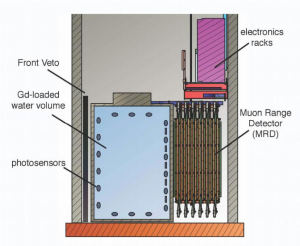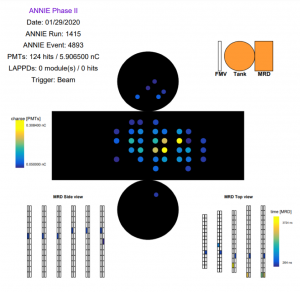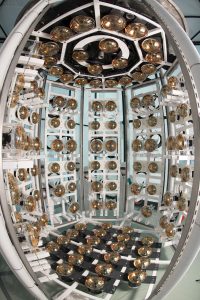The Accelerator Neutrino Neutron Interaction Experiment at Fermilab, known as ANNIE, has seen its first neutrino events. This milestone heralds the start of an ambitious program in neutrino physics and detector technology development. It is also a cause for celebration by the international ANNIE collaboration, composed of groups from Germany, the United Kingdom and the United States, who have been working diligently over the last two years to design and build the experiment.
ANNIE has a list of “firsts” it plans to achieve: (1) the first accelerator experiment to use water doped with gadolinium to efficiently tag neutrons and (2) the first experiment to use new light-detection technology that can track particles with precision better than 100 trillionths of a second.
The new sensors, called large-area picosecond photodetectors, or LAPPDs, were initially developed for particle physics, supported by funding from the Department of Energy’s Office of Science. Since then their development has also sparked interest in their use as a new commercial technology in a wide variety of fields, ranging from medicine to aerospace. ANNIE scientists hope that the use of these photodetectors will allow them to track neutrino events with unprecedented precision in an optical light detector, which would be a major advance in neutrino detector technology.
ANNIE will also be able to try out other new technologies during its planned two-year run, including water-based liquid scintillator and wavelength-sensitive photodetectors, which are also being considered for next-generation experiments. Indeed, the trial of new technologies by ANNIE is expected to have an impact on the design of future neutrino detectors in general.
The ANNIE detector sits in a 30-meter-deep underground hall on the Fermilab site (see illustration below). In the ANNIE design, neutrinos enter from the left and pass through the front veto, which rejects charged particles from neutrino events generated upstream. They then interact in the water volume to create an energetic muon (and possibly other charged particles). These charged particles make a characteristic Cherenkov light flash that is detected by the photosensors that line the wall, top, and bottom of the cylindrical water tank, which is about 3 meters in diameter and 4 meters high. This flash gives information on the neutrino interaction energy and also provides information on the muon direction — critical information for understanding the interaction. If the muon penetrates the full water volume it can enter the muon range detector, which tracks the muon and measures the energy deposited in the iron sandwich.

The ANNIE detector sits in an underground hall at Fermilab. The neutrino beam impinges from the left. The detector consists of three main elements: (1) a front veto to reject charged particles from neutrino events occurring upstream of the hall in the dirt, (2) an instrumented tank containing 25 tons of gadolinium loaded water to serve as both the neutrino target and neutron tagger, and (3) an iron and scintillator sandwich muon range detector to track and range out muons from the neutrino interactions in the target. Image: ANNIE collaboration
The ANNIE detector is currently being commissioned, and in January, it obtained its first neutrino events. In the image shown below, the cylindrical tank containing the doped water and array of photosensors — instruments that detect the neutrino interaction signal — is unfolded such that the sides of the tank appear as a large rectangle, while the circular top and bottom arrays are shown as circles. Each filled color circle represents a photosensor that was hit by Cherenkov light in time with the arrival of the pulsed neutrino beam, with the color scheme proportional to the amount of light (yellow is a high light level, purple is a low light level). The splash of light signals a muon from a neutrino interaction exiting the target volume. After the muon exited the tank it entered the muon range detector, where its track can be seen in the scintillator detectors in both the top and side views. The spaces between the scintillator detectors are filled with 2 inches of iron, and in this case, the muon was able to penetrate all the layers and exit the detector.
This process takes only a few microseconds. The interesting and unique thing about ANNIE is what happens next. Neutrons can be created by the initial neutrino interaction. They can also be created by nuclear interactions in the struck oxygen nucleus (in the water) in a process that is not completely understood. These neutrons slow down and are captured on the gadolinium in the water tank over a much longer time period than the initial interaction (about 80 microseconds), allowing ANNIE to count the number of neutrons as a function of various neutrino interaction parameters to compare to model predictions. Currently, the gadolinium doping of the water is complete, and ANNIE is commissioning this unique part of its sensitivity with artificial-neutron-source deployments. ANNIE scientists expect to start efficiently detecting neutrons in coincidence with neutrino interactions very soon.

The cylindrical tank containing the doped water and photomultiplier tube array is shown unfolded: The sides of the tank appear as a large rectangle, and the circular top and bottom arrays are shown as circles. Each filled color circle represents a photosensor that was hit by Cherenkov light in time with a neutrino beam, with the color scheme proportional to the amount of light (yellow is a high light level, purple is a low light level). Image: ANNIE collaboration
ANNIE’s pioneering accelerator neutrino measurements will contribute to understanding upcoming data from the Super-Kamiokande experiment in Japan, which is planning to add gadolinium to its water this spring. This is an excellent example of international scientific cooperation: the work done by the Super-Kamiokande collaboration in advance of their own gadolinium loading helped guide the design of ANNIE at Fermilab.
This first observation of neutrinos in the ANNIE detector is expected to be followed by several thousands more over the next two years. Results from ANNIE will help physicists understand the role of nuclear effects in neutrino interactions – a topic that is also of critical interest to the international Deep Underground Neutrino Experiment, hosted by Fermilab.
Congratulations to the ANNIE collaboration on reaching this first critical milestone!
Bob Svoboda is a University of California, Davis, professor of physics and member of the ANNIE collaboration.
U.S. support for the ANNIE collaboration is provided by DOE’s Office of Science and National Nuclear Security Administration. UK support is provided by UK Research & Innovation.
Fermilab is supported by the Office of Science of the U.S. Department of Energy. The Office of Science is the single largest supporter of basic research in the physical sciences in the United States and is working to address some of the most pressing challenges of our time. For more information, please visit energy.gov/science.




